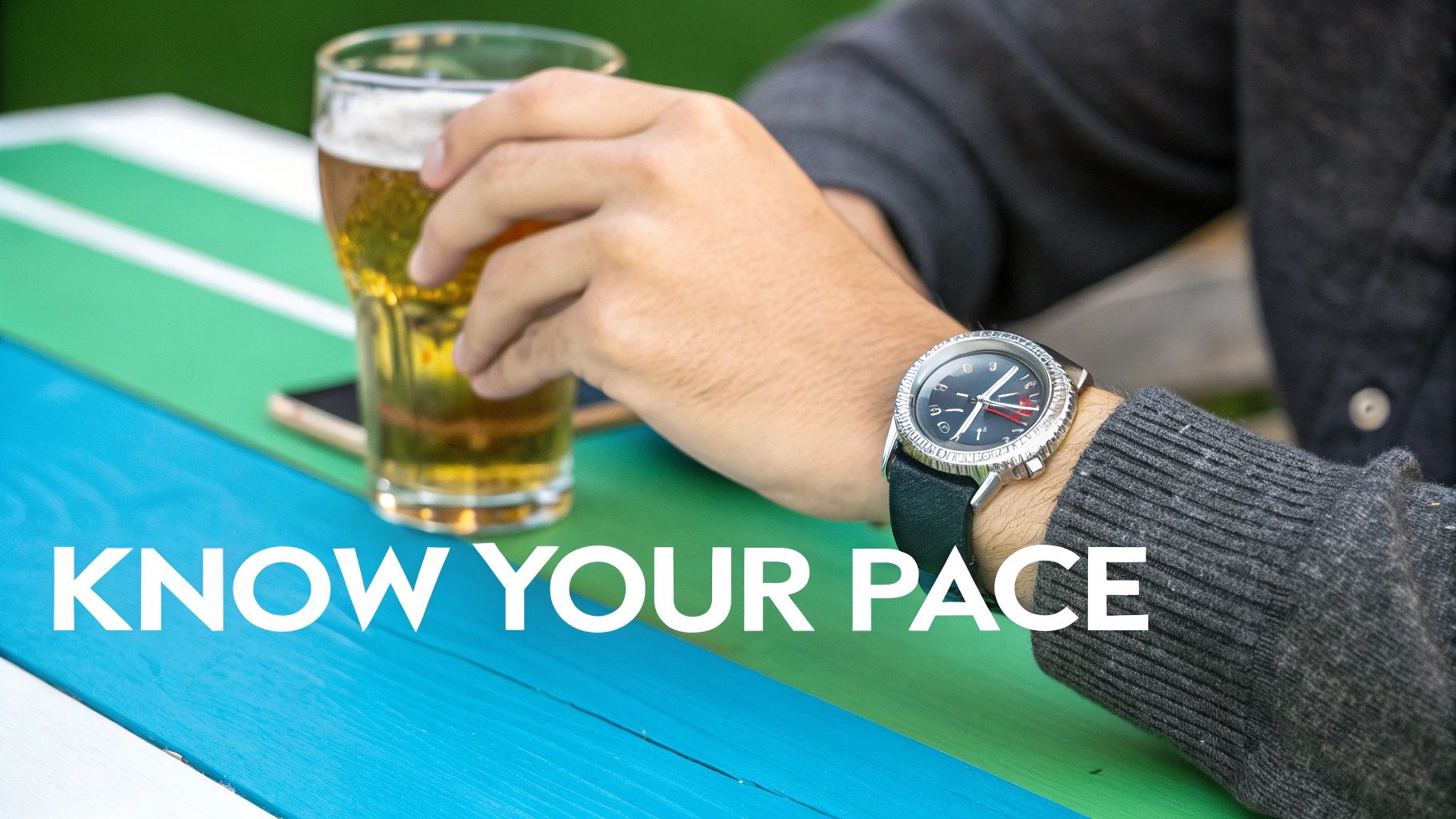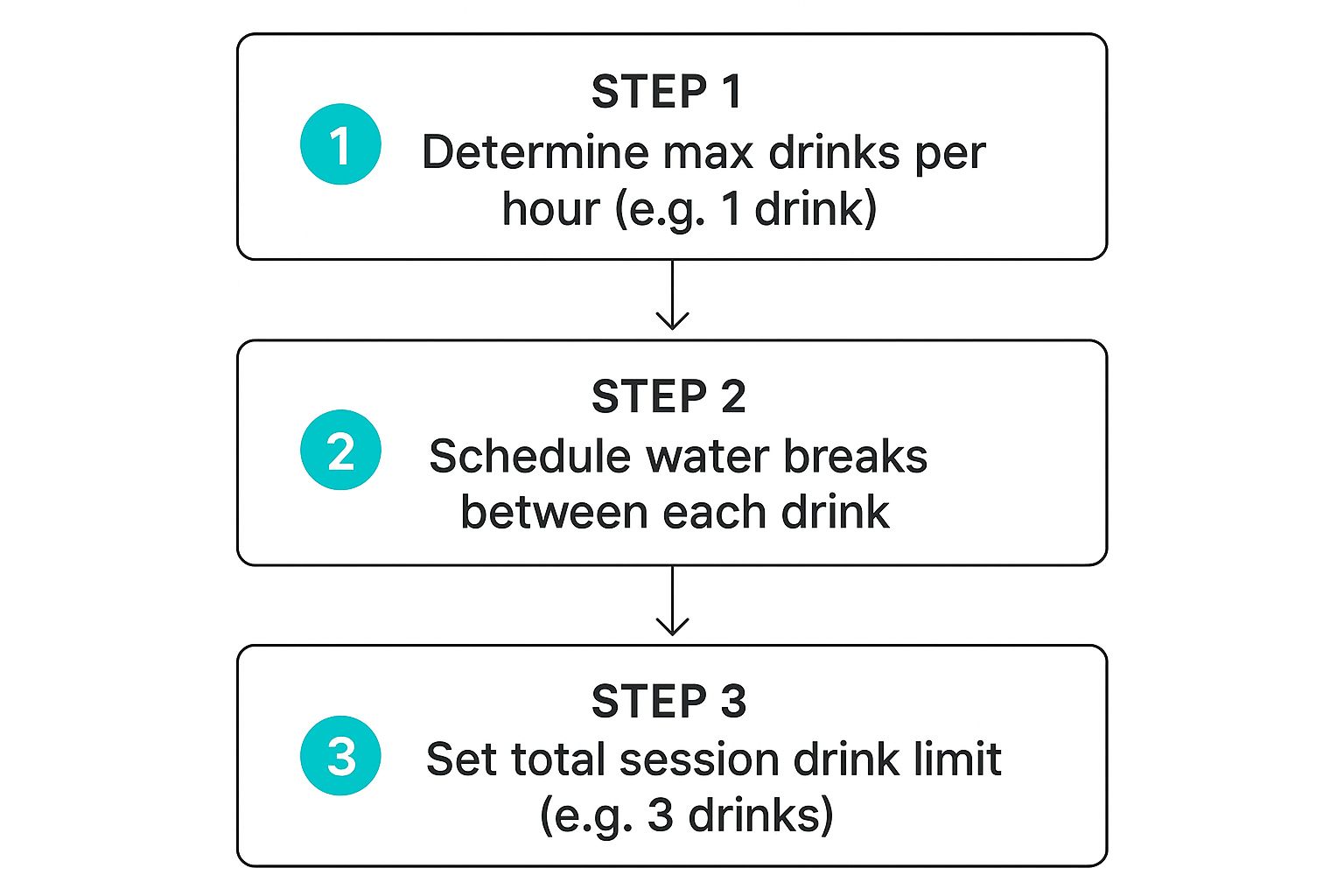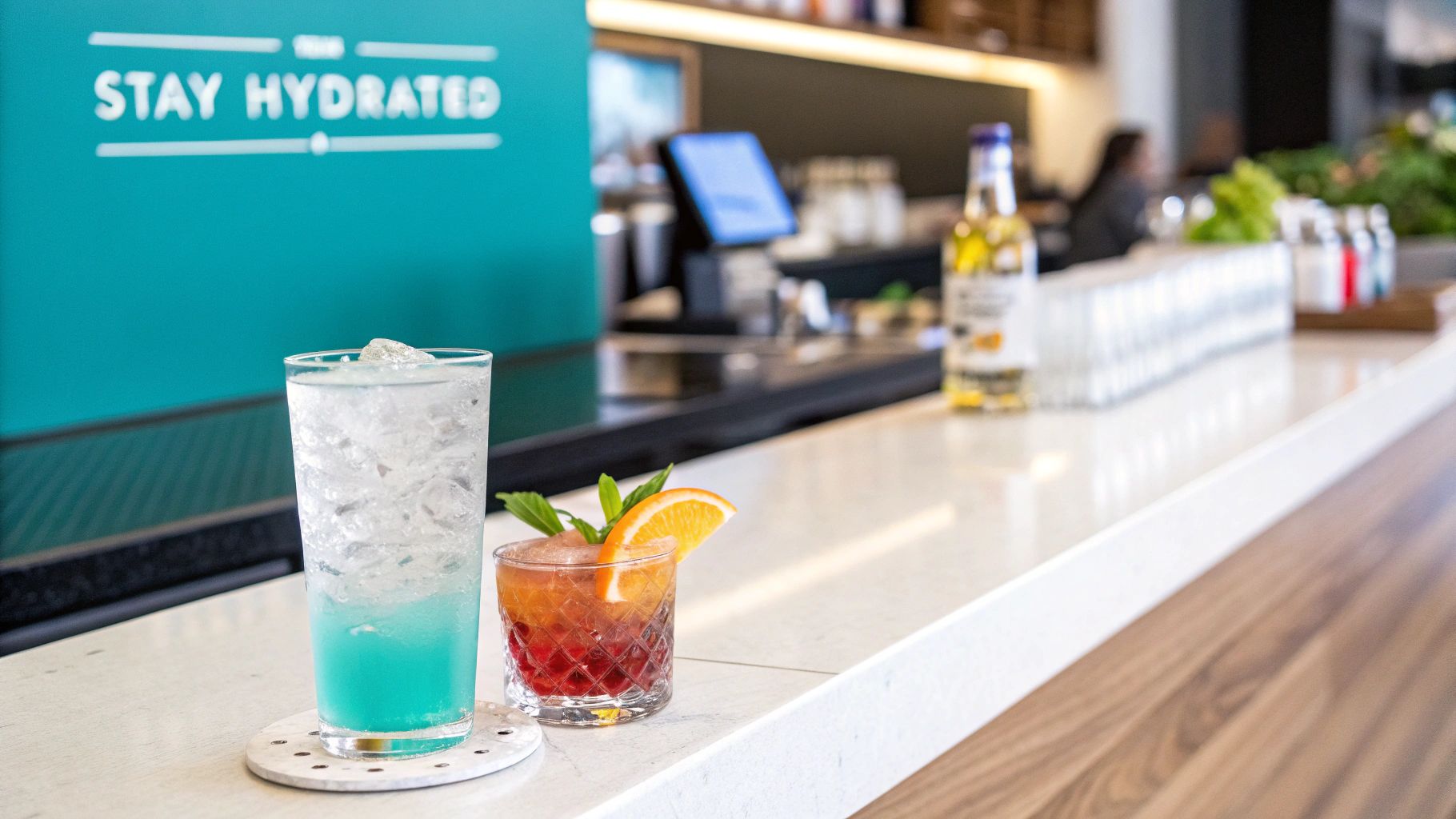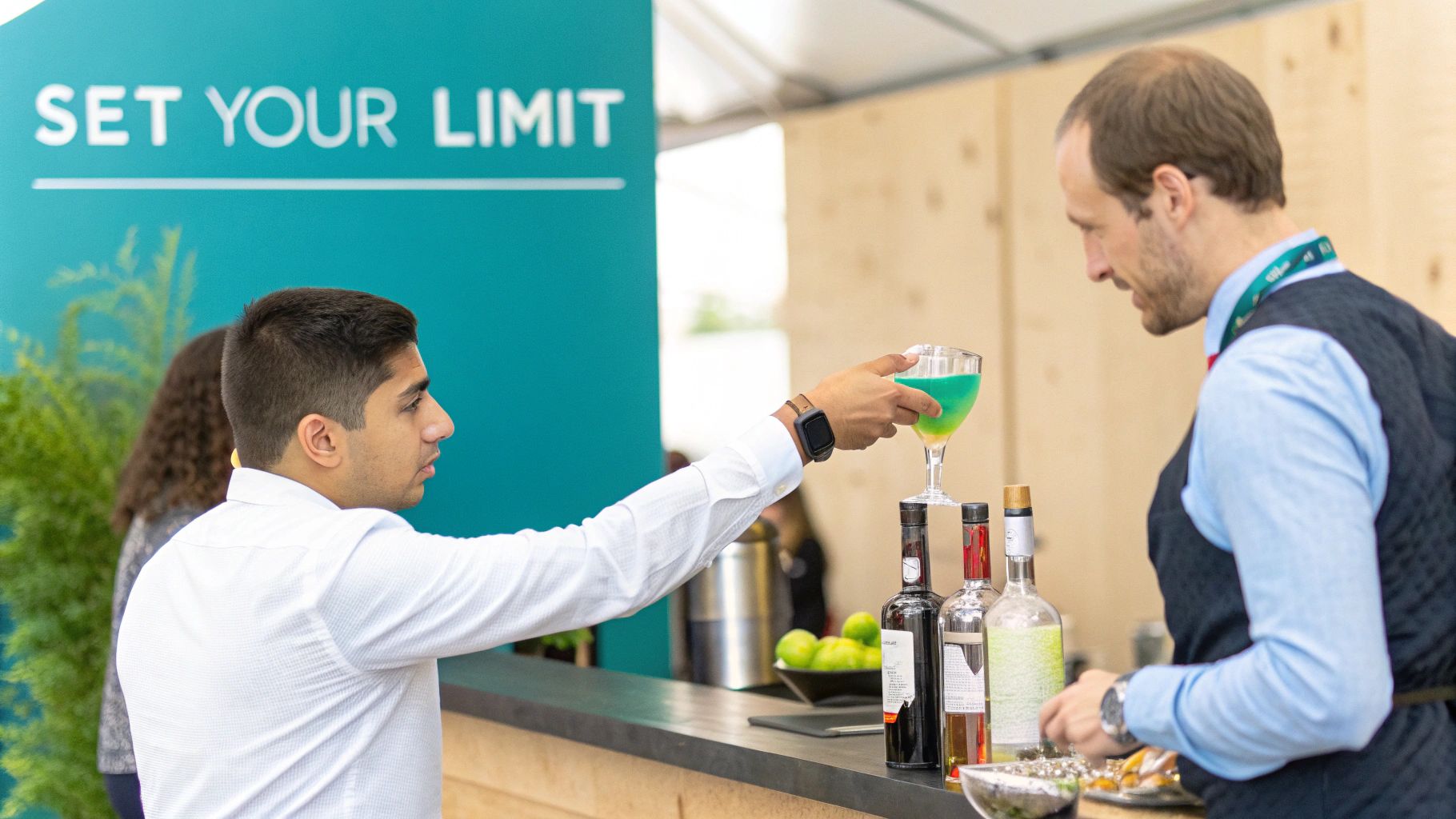

· By Annemarie
How to Pace Yourself Drinking: Practical Tips for Safe Enjoyment
Figuring out how to pace yourself when you're drinking actually starts hours before you even take that first sip. The real secret is all in the preparation. Eat a solid meal, get hydrated with plenty of water, and decide on a drink limit before you head out. Honestly, this simple game plan is your best tool for having a better, more enjoyable night.
Your Drinking Game Plan Before You Go Out

Successfully managing your alcohol intake isn’t just about what you do at the party. It’s all about the smart moves you make before you even leave the house. Think of it less like restriction and more like setting yourself up for a great time.
Build a Foundation with Food and Water
We’ve all heard it, but it’s true: drinking on an empty stomach is a one-way ticket to getting drunk way too fast. Eating a substantial meal beforehand is a non-negotiable step. It's not just about having something in your stomach, either—the kind of food you eat really matters.
A balanced meal can significantly slow down how quickly your body absorbs alcohol. Try to get a good mix of:
- Protein (think chicken, beans, or tofu)
- Healthy Fats (like avocado or a handful of nuts)
- Complex Carbs (things like brown rice or whole-wheat bread)
This combo gives you sustained energy and basically puts the brakes on alcohol absorption, which gives your body more time to process each drink.
The same goes for hydrating before you go out. If you show up already well-hydrated, you'll find it much easier to alternate your alcoholic drinks with water later in the night.
Set Your Intentions for the Night
Before you get swept up in the social energy of the night, take a moment to decide what a successful evening looks like for you. This means setting a clear, realistic limit on the number of drinks you plan to have. Don't just have a vague idea; pick an actual number.
A great trick I’ve learned is to tell a trusted friend what your plan is. A quick, "Hey, I'm only having three drinks tonight, can you help me stick to that?" can make a world of difference.
This kind of proactive mindset is catching on everywhere. For instance, in the United States, where the average alcohol consumption is 9.97 liters per person each year, there's a definite trend toward more mindful drinking. It shows that being intentional about your intake is becoming the new normal. For more on this, you can check out our guide on how to drink in moderation.
Mastering the One Drink Per Hour Rule
You’ve probably heard the "one drink per hour" rule tossed around, but it’s more than just a catchy phrase—it’s a seriously practical strategy that works with your body, not against it.
Think of your liver as a dedicated worker with a fixed processing speed. You just can't make it go any faster. When you start drinking quicker than your liver can keep up, alcohol hangs around in your bloodstream, and that’s when your Blood Alcohol Concentration (BAC) starts to creep up.
This is where the one-drink-per-hour rule becomes your best friend. Your liver can handle the alcohol from about one standard drink every hour. By sticking to this pace, you give your body a fighting chance to metabolize the drink you just had before you introduce another one.
What Is a Standard Drink, Anyway?
Here’s where a lot of people get tripped up. The idea of a "standard drink" is often confusing because, let's be real, drinks aren't created equal. That heavy-handed pour of wine from your buddy at a cookout is a world away from the precisely measured cocktail at your favorite bar. If you want to track your intake accurately, you have to know the measurements.
In the U.S., a standard drink has about 14 grams of pure alcohol. Here's what that generally looks like:
- 12 ounces of regular beer (around 5% alcohol by volume)
- 5 ounces of wine (around 12% alcohol by volume)
- 1.5 ounces of distilled spirits like vodka or whiskey (at 40% alcohol by volume, or 80-proof)
To make this even clearer, here’s a quick reference table.
Standard Drink Sizes At a Glance
This table breaks down what constitutes one "standard drink" for common types of alcoholic beverages, helping you track your intake accurately.
| Beverage Type | Alcohol By Volume (ABV) | Standard Serving Size |
|---|---|---|
| Regular Beer | 5% | 12 fl oz |
| Wine | 12% | 5 fl oz |
| Distilled Spirits | 40% (80-proof) | 1.5 fl oz |
Keep this in mind the next time you're pouring a drink or ordering at a bar. It makes pacing yourself much less of a guessing game.
A quick heads-up: Many craft beers pack a much higher ABV, and cocktails can easily contain multiple shots. Always be aware of what's actually in your glass.
This visual breaks down a simple, three-step way to put this rule into action.

The takeaway here is pretty simple: successful pacing is all about setting smart limits for yourself—both by the hour and for the entire night—and making hydration a non-negotiable part of the plan. When you internalize this, the rule stops being an abstract idea and becomes a concrete game plan.
Your body’s metabolism is surprisingly consistent, so drinking faster than your liver can work is a direct path to getting more intoxicated than you planned. If you're curious about the bigger picture, you can dive into beverage trends and what people are drinking in this insightful market report.
Smart Strategies for Mindful Sipping

Knowing the one-drink-per-hour rule is a decent starting point, but let's be real—mastering the art of pacing comes down to the choices you make in the moment. Pacing isn't just a passive idea; it's a set of active strategies you can pull out of your back pocket at any social event.
One of the easiest and most effective tricks in the book is the "spacer" technique. It's brilliantly simple: for every alcoholic drink you have, follow it up with a full glass of something non-alcoholic. Think water, soda with a lime wedge, or even a diet coke.
This little habit does two crucial things at once. First, it keeps you hydrated (a lifesaver). Second, it naturally slows you down, building some much-needed time between those alcoholic drinks.
Choose Your Drinks Wisely
What's in your glass is just as important as how fast you’re drinking it. Not all drinks are built the same, and a few smart swaps can be a total game-changer for your night.
Next time you're at the bar, keep these tips in mind:
- Go for Lower ABV: Instead of a heavy-hitting IPA, grab a light beer. Swap that full-pour of wine for a wine spritzer. A lower alcohol by volume (ABV) means you're consuming less alcohol with each glass, plain and simple.
- Ditch the Sugary Mixers: Those super sweet cocktails? They're notorious for masking the taste of alcohol, making it way too easy to drink them too fast and have one too many.
The whole point is to be aware of what you're actually drinking. A simple switch can make all the difference in staying in control and enjoying your entire evening without hitting a wall.
Here’s another pro tip I swear by: finish your drink completely before you even think about getting another one. You have to politely say "no thanks" to those well-meaning friends or servers who offer a top-up. Why? Because it’s impossible to keep a real count when your glass is never truly empty.
Finishing your drink creates a definite pause. It's a moment to check in with yourself and decide if you actually want another round. Trust me, that little boundary is one of the most powerful tools you have.
Why You Don’t Want to Drink Too Quickly
Before we get into the how of pacing yourself, let's talk about the why. Honestly, understanding what you're trying to avoid is the best motivation. Learning to pace yourself isn't about killing the vibe; it's about protecting yourself so you can actually enjoy the night and the day after.
Here's the deal: your liver can only process about one standard drink per hour. When you start drinking faster than that, your blood alcohol concentration (BAC) shoots up. This is where things get dicey, fast.
That quick spike is what tanks your judgment and makes you more likely to do something you’ll regret—from a clumsy fall to something far more serious. At its worst, drinking way too much way too fast can lead to alcohol poisoning, which is a legitimate medical emergency.
More Than Just One Bad Night
Beyond the immediate dangers, a habit of drinking too quickly can cause some serious long-term damage. Constantly putting that much strain on your body, especially your liver, is a recipe for disaster. It’s a major contributor to conditions like fatty liver disease, alcoholic hepatitis, and cirrhosis.
The statistics are pretty sobering. In 2019, harmful alcohol use was tied to 2.6 million deaths across the globe—that’s a staggering 4.7% of all deaths that year. What’s even more alarming is that 13% of those deaths were among young adults between 20 and 39. You can read more about these alcohol addiction statistics on nationaldepressionhotline.org.
We’re not sharing this to scare you. It’s a reminder that pacing is one of the smartest things you can do for your health while still having a good time.
Slowing down your drinks keeps your BAC in a much safer zone. You stay in control, sidestep the immediate risks, and drastically reduce the long-term wear and tear on your body. Plus, it's your best defense against a killer hangover, which we break down in our guide on how to avoid a hangover. Pacing is all about making sure you can show up for your life feeling good, not just for the night but for the long run.
How to Handle Social Pressure with Confidence

Knowing your limits is one thing. Actually sticking to them when you’re out with friends can feel like a totally different ballgame. Let's be real, navigating social pressure doesn't have to be this big, awkward thing. A few simple moves can help you own your choices and enjoy the night exactly how you want to.
Sometimes, the best response is the simplest. Having a few go-to phrases in your back pocket means you won't be caught off guard when someone tries to push another round on you.
A casual, "I'm good for now, thanks!" or a straightforward, "I'm pacing myself tonight," usually gets the message across without any drama. You don't owe anyone a dissertation on your drinking habits. Keep it light, friendly, and firm.
Your Go-To Scripts for Saying 'No Thanks'
When you need a quick and easy way to pass on a drink, give one of these a try:
- "I'm driving, so I'm taking it slow tonight."
- "Thanks, but I'm sticking with water for this round."
- "I've got an early morning, so I'm wrapping it up on the drinks front."
Another pro move? The stealth non-alcoholic drink. Ordering a club soda with lime in a highball glass looks just like a cocktail and lets you blend right in. It’s a simple trick that shuts down the questions before they even start, so you can focus on the people you're with, not what's in your glass.
The point is to feel comfortable, not conspicuous. Whether you’re holding a gin and tonic or a seltzer, you’re there for the good company. Your drink choice is just that—your choice.
Ultimately, learning how to pace yourself is an act of self-care. It’s about staying in control, feeling your best, and actually remembering the fun you had. For more on this, check out these essential tips for responsible drinking to build up even more confidence for your next night out.
Got Questions About Pacing Your Drinks?
Even when you've got the best game plan, a few old myths about drinking can throw you off. Let's tackle some of the most common questions head-on so you can feel confident and stay in control.
Can a Big Meal After Drinking Sober Me Up?
Ah, the classic late-night food run. We've all been there, thinking a greasy slice of pizza or a giant burrito is the magic bullet. But honestly? It’s a myth.
While eating before or during your drinking session is a brilliant move to slow down alcohol absorption, it doesn't work in reverse. Once the alcohol is in your bloodstream, only one thing can get it out: time. Your liver needs to do its job, and sadly, that plate of fries won't speed up the process.
Is It Okay to "Catch Up" if I Start Drinking Later?
This is probably one of the biggest mistakes you can make, and it’s a surefire way to end your night early. Trying to match your friends drink-for-drink when you've just arrived is a recipe for getting way too drunk, way too fast.
Your body can only process about one standard drink per hour. That rate doesn't magically speed up just because you're behind. Gulping down drinks to catch up just floods your system, sending your BAC through the roof along with all the risks that come with it. It's always better to stick to your own steady pace, no matter when you start.
Key Takeaway: Intoxication isn't about the total number of drinks you've had all night; it's about how much alcohol is in your system at one time. A steady pace is always the smarter, safer bet.
Does Coffee Actually Help With Intoxication?
That vodka red bull might feel like a good idea, but mixing caffeine with alcohol is a tricky game. Caffeine, a stimulant, masks the effects of alcohol, a depressant. It can make you feel more alert, but here's the critical part: it does absolutely nothing to lower your BAC or improve your foggy judgment.
This "wide-awake drunk" feeling is dangerous. It can trick you into thinking you're sober enough to have another round or make other risky decisions. Remember, caffeine doesn't give your liver superpowers—it's still working at the same pace.
By busting these myths, you’re much better prepared to pace yourself for a great night out and an even better morning after. For an extra layer of support, give the hangover-fighting power of Upside Hangover Sticks a try. Learn how Upside can help you wake up feeling refreshed.
